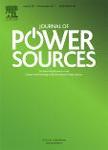版权所有:内蒙古大学图书馆 技术提供:维普资讯• 智图
内蒙古自治区呼和浩特市赛罕区大学西街235号 邮编: 010021

作者机构:Korea Inst Ceram Engn & Technol Elect Mat Convergence Div Seoul 153801 South Korea Inha Univ Dept Ceram Engn Inchon 402751 South Korea Nelsom Mandela African Inst Sci & Technol Dept Mat Sci & Engn Arusha Tanzania
出 版 物:《JOURNAL OF POWER SOURCES》 (电源杂志)
年 卷 期:2014年第262卷
页 面:323-327页
核心收录:
学科分类:0820[工学-石油与天然气工程] 08[工学] 0807[工学-动力工程及工程热物理] 0805[工学-材料科学与工程(可授工学、理学学位)] 0703[理学-化学]
基 金:Fundamental R&D Program for Core Technology of Materials - Ministry of Trade Industry & Energy Republic of Korea
主 题:Solid oxide fuel cell Segmented-in-series Decalcomania method Active area
摘 要:Solid oxide fuel cell components are fabricated using the decalcomania method. Then a flattened tubular segmented-series solid oxide fuel cell (SIS-SOFC) stack is prepared on each side (front, right, left and back sides) of ceramic support with a uniform thickness. SIS-SOFC laminated on all sides of the porous ceramic support show 2.6 times more active area per cell than the case involving only single side lamination. Power output increases by 2.5 times with higher open circuit voltage. This is attributed to the increase in active area per cell and sizable decrease in sheet resistance and polarization resistance by laminating the cells on all sides. For cells laminated on decalcomania paper, they show no sign of component materials penetrating through pores in ceramic support and have better interfacial bonding. Furthermore each cell component formed a uniform thickness layer. (C) 2014 Elsevier B.V. All rights reserved.